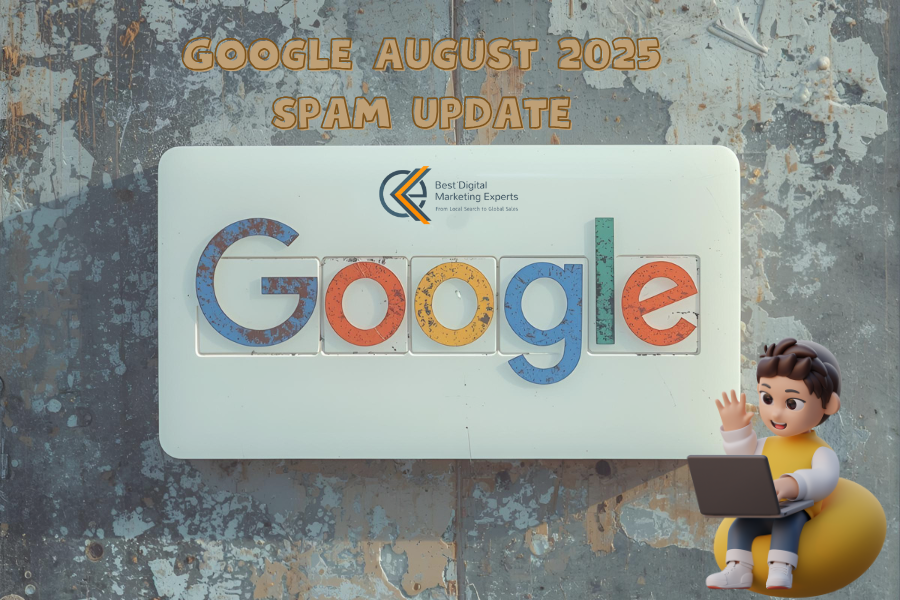Introduction
The internet woke up to a new major enforcement move from Google and The Google August 2025 spam update algorithm. The update was released by Google and was released on the 26th of August 2025. The update is described as an “normal spam update” and is applicable to all languages. For publishers, site owners and SEOs, it’s time for a thorough review of links, content and website behavior that may be considered manipulative or spammy. In this article, I’ll outline what the change is and why it’s important and who’s more likely to suffer, the best way to determine if your website is affected and importantly, the most effective, prioritized recovery plan that you can implement immediately.
What exactly did Google say? Google has officially stated
Google’s public signal as well as Google’s public signal and Search Status Dashboard show the August 2025 update to the Google August 2025 spam update algorithm was made public on August 26 2025. The date is August 26, 2025. the rollout could take couple of weeks. Google classified the update as a Google August 2025 spam update update, that is, its enhancements to automated systems for detecting Google August 2025 spam update instead of a general change in the core of relevance. This distinction is crucial because Google August 2025 spam update updates typically perform the role of surgical improvements to the methods Google detects manipulative behavior (as in contrast to the broad changes to how Google assesses relevancy across the various queries). In simple terms, this update is about detection of spammy signals and removing them from search results across the globe.
Why this is important (short version)
Google August 2025 spam update are usually targeted, and when they are released, they can create significant volatility for websites which rely on shortcuts. Websites that have genuine quality content typically get through these updates with no permanent damage. Sites constructed on thin pages, templates for doorway-style websites, scraped content, or ad-hoc link schemes are much more prone. Since this particular update is multilingual and global its reach is broad, so even sites that are niche should be vigilant.
What are the most likely targets of the update (based on Google policies)
Google seldom releases the line-by-line codes of updates. But, analysis of patterns from previous spam updates and Google’s spam policy suggest the rollout of August 2025 was focused on:
- Low-value or thin content as well as “content mills” -sites that serve to attract traffic to search engines, but without offering any significant value to the user.
- Pages for Doorways and massively scaled local pages templates which are duplicated across cities, or keywords that have tiny variations.
- Claiming and sneaky redirects – telling users one thing but another one to search bots or redirecting users after a clicking.
- Scraped or non-original content Republished content that has little or any originality or context.
- Automatic spam websites and massive account posting Automated large-scale is designed to generate reviews, links or listings at a massive scale.
- Links that have been manipulated or advertising -Backlinks with low quality designed to artificially increase rankings.
- fake reviews and abuse of reputation made reviews or reviews sourced from dubious sources to alter local results.
- False or misleading behavior -malware, phishing or other fraudulent methods that hurt users.
As Google’s spam-detection system has been improved iteratively (SpamBrain and the related models) This update will likely be an improvement to rules and thresholds to detect the patterns with greater accuracy.
Snapshot of the real-world impact as well as community reports
Within the first 48-72 hours following the rollout various third-party tracking software and news websites from the industry showed increased volatility in rankings trackers and visibility indexes. The SEO community reported a range of results: some websites have recovered from previous suppressions, while others experienced sharp drops, while some reported indexing flashes (pages that were removed out of the search results or have lost places). The diversity of reports suggests that the change eliminated certain “Google August 2025 spam update” winners and re-weighted certain legitimate sites — sometimes improving the visibility of sites which adhered to the best practices and penalizing those relying on a manipulative strategy.
How do you determine if the Google August 2025 spam update affected your website?
Check this checklist to verify the impact and scope of this checklist:
- Google Search Console (GSC):
- Review the Performance report for sudden decreases in clicks, impressions, or average positions aligned to Aug 26, 2025, and the next weeks.
- Review Manual Actions — If a manual action is present, you’ll find it (manual actions are distinct from algorithmic modifications, but always make sure to check).
- Index the coverage of pages and checks at page level
- Find out if there is a mass deindexing, or a decrease in indexed URLs. Use the Coverage report to look at specific pages that are affected with an URL Inspection Tool.
- Crawl logs and server
- Be aware of changes in Googlebot activity. If a lot of pages are searched for and then deleted from Google’s index it’s an indication that Google is screening these pages.
- Backlink audit:
- Run a backlink quality check. Check for increases in links with poor quality and abrupt links from directories, insignificant networks, as well as interlinking domains of networks.
- Content inventory:
- Find doorway-style templates, templated pages, pages that have no distinct content, and any content that is syndicated but has no value added.
- Compare with other competitors as well as trackers
- If the market is experiencing a wide-ranging volatility then it’s likely to be due to the algorithm being at fault, rather than a specific technical issue at the site.
Instant remediation (tactical fixes that you can put into place this week)
If you’re hit the hardest, prioritize your actions based on the force and speed of execution:
- Remove or noindex doorway and thin webpages. If a page is not of much value to users then remove it or make it the page to noindex until it is upgraded.
- Reconsolidate duplicates. Merge multiple thin pages to create a single, authoritative webpage with depth. Make use of canonical tags in a responsible manner.
- Clean up your backlinks. Identify toxic link sources, then contact webmasters to take down hyperlinks, and create a disavow only in the event that cleaning requests fail and the links are deemed to be dangerous.
- Stop the cloaking and sneaky redirects. Ensure the user gets the same information that Googlebot sees Googlebot and that the redirects are transparent and logical.
- Check UGC (user-generated material). Moderate comments forums, reviews and forum posts to get rid of duplicate or spammy content that is not of any value.
- Reevaluate the AI driven content. If you use automated generation, include human review, and ensure that your pages contain unique information, knowledge, or data.
- Patched content that has been hacked If attackers have created doorway pages, encrypt the site and patch the flaws.
What is the significance of cleaning even if recovery may not be instantaneous
Google August 2025 spam updates are generally beneficial to automated systems. In contrast to a manual process which requires you to submit an appeal for reconsideration, recovering from algorithmic hits occurs when the signals change and the algorithms re-evaluate your website. This means that you need to remove negative signals, increase the quality, and allow Google time to refresh. In the past, some sites have seen improvements in their performance quickly, while others could take weeks or months, depending on the speed at which they implement changes and the seriousness of the issue.
Deeper technical diagnostics
- Testing crawling and rendering: Use GSC’s URL Inspection to confirm that Googlebot can see what the users see.
- Chains of redirect and Header responses Make sure redirects have only for a purpose (e.g. that redirects are not permanent and are not obscuring content).
- Meta robots as well as meta robots. Be sure to look for possible disable as well as noindex which could cause problems.
- Structured data use: Ensure review and local business schemas aren’t being misused to show fake information and fake reviews.
- Templates that can be scaled: Pages created purely by swapping city names or keywords should be scrutinized and are often removed.
AI content Automation, AI content and Spam signals
Automated content and models that generate are tools and tools are judged by the products they produce. If AI content is meticulously edited and re-edited using primary data, it could prove beneficial. When it’s utilized to turn out thousands of similar pages with no edits, it’s an obvious Google August 2025 spam update signal. This update for August 20, 2025 bolstered model detection patterns that identify repetitive phrasing and duplicate structure as well as indications of low-value automated scaling.
Business listing and local pack impact
Local businesses may be affected by the update that uncovers fake or fraudulent profiles. Multiple listings, fake reviews or groups of sybil accounts utilized to increase the visibility of a listing are common signals of Google August 2025 spam update. If you notice that a Google Business Profile showed dramatic changes in visibility, you should audit reviews, amend NAP information, and eliminate duplicate profiles. To recover local data, record authentic reviews and provide verifiable business information.
Case studies that are practical (hypothetical but typical scenarios)
- Coupon aggregator (templated cities page): Many pages weren’t indexed after the update, as each page provided a limited amount of value. The recovery required the consolidation of coupons and guides to regions, with distinctive editorial content and user-friendly features.
- Micro-news websites that promote syndicated feeds Sites which republished content from third parties without adding reporting lost their visibility. Recovery required distinct reports, oversight of editorial, and author attributing.
Long-term strategy (winning and long-lasting method)
- E-E-A-T (Experience Expertise, Expertise, Authoritativeness and trust): Use author bios, authentic credentials, as well as primary data.
- Quality over Scale: One comprehensive page is superior to 50 thin templates.
- Natural link building: Avoid link schemes. Create relationships, citations or editorial links.
- Website hygiene Maintain security, canonicalization accurate and accurate structured data.
- The rules for AI use: If you use automation, make sure you have strict editorial pipelines as well as human checks.
A 30-day action plan that is prioritized.
Week 1: Audit and triage: content inventory as well as backlink scans and GSC reviews.
Week 2: Improvements such as noindex thin content, eliminate hacks, and fix the redirect, cloaking and other issues.
Week 3: Editorial updates Rewrite and consolidate and add author profiles and increase the depth of your page.
Week 4: Monitoring and outreach Request removal of links monitor traffic, and keep track of every modification.
Timelines and recovery measures
Expect a time for evaluation following fixings. The algorithmic systems need refresh cycles. Some improvement can be seen in a few days, but complete recovery can take months, depending on the severity of the issue and how fast you address the root cause. Keep a current list of changes to ensure you can track actions and improvement.
Common myths
- “One low-quality page will doom the entire site.” It’s not always the casealgorithmic Google August 2025 spam update detection looks at the patterns and signals across the entire site. A single page is rarely the cause of total removal of a site in the event of malicious activity.
- “Disavow will instantly fix everything.” There is no way to fix everything, disavow is only an instrument for cleaning up and usually results in slow or minimal improvements to algorithmic hits.
- “AI content equals automatic penalty.” It’s not immediately — the penalty is imposed for the production of low-quality or mass-produced content and not just the usage of AI.
Checklist (one-page action list)
- Examine GSC the manual action and report on performance.
- Check indexed pages for errors and flag content that is not indexed.
- Remove or noindex pages.
- Clean profile for backlinks Request removals and write an unavowed disavow, if required.
- Correct cloaking and sly redirects.
- Improve author attributions as well as E-E-A-T signals.
- Remove local listings that are hard to find and false reviews.
- Trackers from third parties and pertinent community reports.
Closing: the long-term view
It is believed that the Google August 2025 update to the Google August 2025 spam update algorithm is a further indication that search engines value legitimate value over tricks. If your website was affected, concentrate on auditing, cleaning improvement, and documentation. As time passes, a consistent quality increases resilience. Top-quality websites are those which recover and increase their reputation as the process of detecting Google August 2025 spam update becomes more specific.
Document, monitor and then iterate Make small, measurable improvements every week and then re-evaluate the index and traffic signals to monitor the recovery.
Be sure to keep stakeholders updated and up-to-date.
FAQs About the Google August 2025 Spam Update
1. What’s this Google August 2025 update to the spam algorithm What’s the spam update for August 2025?
Google August 2025 update to spam is a major algorithm change that was released on the 26th of August 2025. It is designed to increase the detection of spam and to reduce low-value or manipulative results in results from searches.
2. Who will be most likely to be affected by Google August 2025 update spam
Sites that have poor content, doorstop pages, spammy backlinks duplicate templates, and excessive AI-generated content without human review are the most likely to be affected.
3. How do I know whether my website was affected with the Google August 2025 update to the spam algorithm
Do you check the Google Search Console performance reports for sudden ranking or traffic drops, check for pages that have been deindexed and examine your content and backlinks during the time of the rollout.
4. What is the time frame for recovery following the Google August 2025 update to the spam algorithm
The timeline for recovery varies. Some sites see improvement within weeks if the issues are resolved swiftly, whereas others could require a few months while Google’s systems evaluate modifications.
5. Do AI-generated contents trigger penalties as part of the Google August 2025 update to the spam algorithm?
AI content is not penalized on its own. However when AI uses it to build large quantities of low-value or duplicate pages they could be classified as spam. The addition of human review, creativity and unique information can help avoid problems.
6. What actions should I take in the event that my rankings have dropped following this Google August 2025 update to the spam algorithm
Prioritize the removal or improvement of the quality of your content, removing toxic backlinks, repairing cloaking/redirect issues, combining duplicate pages and bolstering E-E A-T signals such as author credibility and trusted sources.
7. Does this Google August 2025 update to the spam algorithm different from the core update.
Core updates alter the way Google rates all content in terms of relevancy and quality, whereas spam updates are specifically designed to improve the methods to detect and block the use of spam or manipulative practices.



